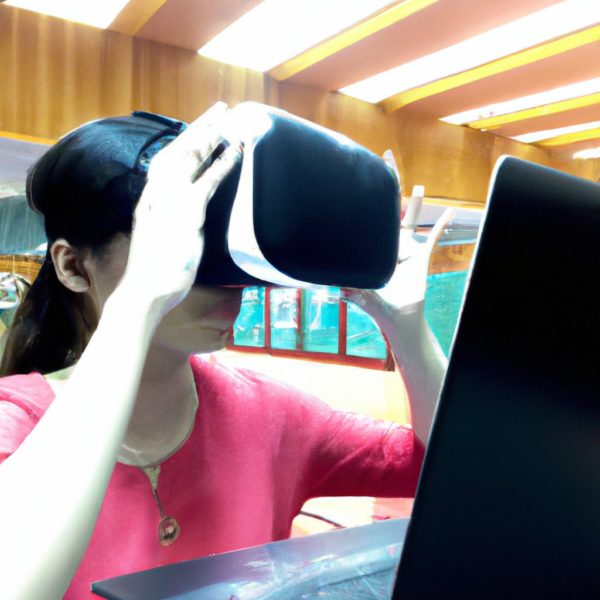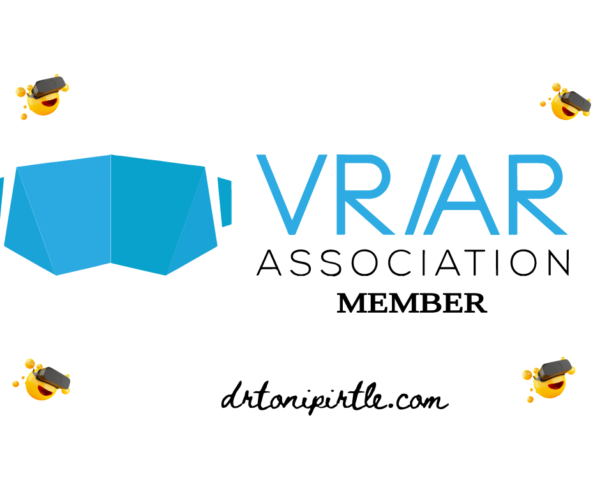Tag: metaverse
Train the Trainer Tips for VR

Managing a classroom of people wearing virtual reality headsets can be a unique and challenging experience for both the teacher and the students. Here are some tips on how to effectively manage a classroom of people wearing virtual reality headsets:
Establish clear rules and expectations: Make sure to set clear rules and expectations for behavior while wearing virtual reality headsets. This could include guidelines on movement, communication, and appropriate use of the technology.
Provide clear instructions: Ensure that all students understand how to use the virtual reality headsets and any software or apps that are being used in the classroom. Provide clear instructions and demonstrations as needed.
Monitor student behavior: Keep an eye on students’ behavior while they are using virtual reality headsets. Be aware of any signs of disorientation, discomfort, or inappropriate behavior, and intervene if necessary.
Use collaborative activities: Consider using collaborative activities that require students to work together in virtual reality. This can help build teamwork and communication skills and can also be a fun way to learn.
Use virtual reality to enhance learning: Use virtual reality as a tool to enhance learning, not just as a novelty. Incorporate virtual reality experiences that align with your curriculum and learning objectives.
Consider accessibility: Keep in mind that some students may have difficulty using virtual reality headsets, such as those with certain disabilities or medical conditions. Consider alternative activities or accommodations for these students.
Overall, managing a classroom of people wearing virtual reality headsets requires careful planning, clear communication, and constant monitoring. With the right strategies in place, virtual reality can be an effective tool for enhancing learning and engagement in the classroom.
Which HEI’s Are Using Virtual Reality

There are many universities in the United States that are using virtual reality (VR) for instruction. Here are a few examples:
1. Stanford University
2. University of Southern California
3. Harvard University
4. MIT
5. Duke University
6. University of California, Berkely
7. Ohio State University
8. University of Texas at Austin
9. Columbia University
10. New York University
These institutions are using VR for a variety of purposes, including enhancing experiential learning, increasing student engagement, and improving accessibility to education. VR is being used in subjects such as medicine, engineering, architecture, art, and more. It’s important to note that this is just a small sample of the universities that are using VR for instruction. Many institutions, including colleges, are actively exploring and experimenting with VR technology, and the list is constantly growing. More to come on the list of colleges…..

What is an Immersive Learning Policy?

Humble Beginnings!
When I began teaching Social Media and Social Media Strategy, in the first decade of the 21st century, it was new to us! There was actually a time before social media, and in those days, education establishments used traditional marketing efforts. However, it became clear to institutions that they needed to adopt social media to support their marketing plans. I was fortunate to be assigned a special project by my college. I was asked to develop my college’s social media networks and social media presence in a strategic manner. It was a great opportunity to use social media to reach our students and our community. My focus at that time was to build a Social Media Strategy, that had measurable social media objectives, as well as the building of a Social Media Policy, that clearly identified guidelines for users.
I am proud of the contribution I made to my school and my community in the realm of social media, back then, and my passion for developing student engagement and community relationship building through the internet continued to grow! In 2021 I successfully defended my doctoral dissertation on “California Community Colleges: Social Media Practices, A Qualitative Case Study. The study provided recommendations and guidance for higher education leaders in developing social media strategies to support the goals of the California Vision for Success.
The world is abuzz with Web3.0, VR, Immersive Learning & AI
And, here we are today, and the world is abuzz with the evolution into Web3.0, Virtual Reality, Immersive Learning, and Artificial Intelligence! It is a time, just like the time when social media emerged, that institutions need a plan! Institutions are utilizing virtual reality tools to support student learning, engagement and success. It is important that institutions develop strategies and policies on learning utilizing immersive technologies, and I outline below what to consider as a part of an Immersive Learning Policy.
Immersive Learning Policy
A comprehensive Immersive Learning Policy would outline guidelines and support for the effective use of immersive technologies, such as virtual reality (VR) and augmented reality (AR), in education. The policy would address important issues related to technology, instructional design, faculty development, student support, assessment, privacy, and security. Below are items to consider when developing the plan!
Purpose and goals
Outline the goals and objectives of using immersive technologies in education, such as enhancing student engagement and improving learning outcomes.
Technology standards
Specify hardware and software requirements for immersive technology systems and ensure that they meet accessibility standards.
Instructional design
Provide guidelines for creating effective immersive learning experiences, such as incorporating interactivity, providing feedback, and balancing immersion with learning objectives.
Faculty development
Offer training and support for faculty to effectively integrate immersive technologies into their teaching and create engaging and effective learning experiences.
Student support
Provide resources and support for students using immersive technologies, such as technical assistance, online tutorials, and help desks.
Assessment and evaluation
Develop methods for evaluating the effectiveness of immersive learning experiences, including both formative and summative assessments.
Data privacy and security
Address privacy and security concerns related to the use of immersive technologies in education, including data storage, access, and privacy policies.
Evaluation and continuous improvement
Regularly evaluate the effectiveness of the Immersive Learning Policy and make changes as needed to ensure that it is meeting its goals and objectives.
If you have any questions, or suggestions, by all means reach out!

How to fully enjoy the virtual reality experience!

It is important to be comfortable
It is important to know how to fully enjoy the virtual reality experience in a headset! You must be comfortable, and you must know how to avoid the nausea and dizziness feeling that people report ! I am now a regular headset user, but when I started out, I too experienced a small amount of nausea and dizziness, but thankfully I developed strategies that proved very helpful! I thought it important to share how to enjoy the VR experience when wearing a headset! If you, or someone you know, experiences nausea or dizziness, read on, these tips might help!
But that nausea and dizziness!!!!
When I began using the Meta Quest 2 headset, there were occasions when I felt nauseous, and sometimes I felt dizzy. This typically happened when I was using apps that involved a lot of movement around me, or, had me arrive at a location that appeared to be high up above the ground! I do not do well with heights or fairground rides, so it makes sense that in VR I would have some difficulty with that too. I also struggled with the weight of the headset on my face! Despite these early difficulties, I soldiered on, and I believed that having the virtual reality opportunity and experiences justified taking the time to become more familiar and comfortable! Just like learning to ride a bicycle when I was a child, or when I learned to ski, I had to learn strategies to ensure I could be safe and effective to fully enjoy the experiences, and this new experience was no different!
I began my virtual reality experience by taking frequent breaks, whereas now I am a user who loses complete track of time – and I now set my event alarm on my phone–a lot!!! Early on, I also found the weight of the headset on my face to be uncomfortable, it made my head ache! I ventured online to see what could help me with that, and I settled on purchasing a BoboVR! The BobVR attaches to my headset strap and balances the weight nicely – it even holds a portable battery too! Did I say I lose track of time in the headset? That also means that I run out of juice regularly, so having a wearable spare battery is very helpful!
Tips on how to enjoy your virtual reality experience
My own experiences with headsets, and watching students and friends wear headsets, leads me to the purpose of this blog post, which is to provide tips on how to enjoy the VR experience when you are wearing your headset, so here goes:-
- Adjust the headset to make sure it fits comfortably and securely on your head
- Try to keep your head level and still when using the headset
- If possible, reduce the brightness and contrast of the visuals displayed on the headset.
- Take frequent breaks from the headset every 15-20 minutes to avoid onset of dizziness and nausea
- Move slowly in virtual reality to avoid triggering the vestibular system and potentially cause dizziness
- Sit in a stationary chair while using the headset to help maintain balance
- Adjust the Interpupillary distance (IPD) settings on the headset to help with the focus and alignment of the lenses for your eyes
- Consider purchasing prescription lenses – they are reasonably priced! A friend of mine just purchased a pair of prescription lenses for her Quest for $80
- Increase frame rate: Lower frame rates can increase dizziness for some people, adjusting the frame rate in the headset settings may help.
- I have heard from other friends that chewing gum while using the headset works too, but I haven’t tried that myself!
- Consider searching online for headset straps – you will be surprised how many gadgets are out there to help you to be comfortable. I personally recommend the BoboVR.
I hope these suggestions give you some relief if you are having problems with being physically comfortable while spending time in virtual reality! I no longer struggle at all and am a regular VR user 🙂 By all means if you have any tips to add, please comment!
VR & The New Form of Education Establishment

Between the 1990’s and today, education establishments, and our classrooms, have evolved into places where the use of web pages, internet databases, and interactive online tools, including social media, have become a part of the furniture so to speak! In my view, virtual reality is the next best use of the internet for the classroom and for education establishments! Much like the students of today expect and demand online learning experiences, so too will the learners of tomorrow (which is not that far away) have an expectation for education establishments to provide them a 3D virtual learning experiences.
The Immersive Experience
With the help of VR technology, students can currently have immersive and interactive experiences that can enhance their understanding and retention of complex concepts. It can provide students with access to resources and simulations that they wouldn’t be able to experience otherwise. By immersing students in simulated settings, VR provides an engaging and interactive learning experience and enables students to gain a better understanding of complex concepts – in effect, it helps bridge the gap between theory and practice,
Complementing Instruction With VR
Virtual reality can complement student studies in several ways:
Hands-on learning: VR provides students with a hands-on, interactive experience that can help them better understand and retain complex concepts. For example, students can explore a virtual environment to learn about anatomy or chemistry.
Immersive simulations: VR simulations can allow students to experience real-world scenarios in a safe, controlled environment. This can be especially useful in fields such as medicine, engineering, and architecture, where hands-on experience is essential.
Access to remote resources: With VR, students can access resources from anywhere in the world, such as virtual museum tours or virtual field trips.
Skill development: VR can provide opportunities for students to develop important skills such as teamwork, problem-solving, and critical thinking.
Increased engagement: VR can increase student engagement and motivation, leading to a more positive learning experience.
The Digital Twin
Higher education establishments must prepare to embrace Virtual Reality not only as a method of instruction, but also as a way to provide educational services. The campus setting that was built for the boomer generation (the largest generation), has become antiquated and expensive to maintain. The campus setting services a declining population today yet the learner needs of the post covid pandemic are much different than what our institutions were designed for. By the creation of a digital twin (a digital 3D copy of the physical campus) student services may be provided in real time, cost effectively, in a 3D environment – as and when needed.
Metaversities
There are currently 10 Universities in the US that have already built their “digital twin”, also known as Metaversities. They are: Morehouse College in Georgia, the University of Kansas School of Nursing, New Mexico State University, South Dakota State University, Florida A&M University, West Virginia University, Southwestern Oregon Community College, California State University, Alabama A&M University and University of Maryland. They have been planning for students to visit their virtual campus from anywhere. Read more about that here! https://www.govtech.com/education/higher-ed/10-universities-to-launch-digital-twin-metaversities
So, is virtual reality a threat to higher education establishments?
More to come 🙂
Artificial Intelligence & Virtual Reality in Education

Artificial Intelligence has revolutionized the virtual reality experience by bringing a whole new level of realism and interactivity to it. AI-driven applications can now track user movements, detect facial expressions, and understand voice commands, allowing users to feel as if they are immersed in a virtual environment with realistic interactions. In addition, AI is being used for natural language processing which helps create immersive conversations with digital characters and objects in VR. This technology is making virtual reality more engaging than ever before, and with these advances, it means that teachers will be able to prepare our students for the future workforce where they can be employed by any industry and use any technology.
The project I am working on is training teachers how to use VR to support their curriculum, and I have been fortunate enough to be able to work with them. I am very excited for students to have the opportunity to utilize immersive technologies in their learning because they are more engaging than traditional classroom learning. I am so excited for the students who will have the privilege of using immersive technologies in their learning. I’ve seen firsthand how these technologies can transform and enhance the learning experience of adults, and I am confident that students will also find themselves more engaged and motivated thanks to their use. A quick search for scientific research proves my point – the research is showing that immersive technologies are a major positive for learners of all ages.
I am thrilled that I have the opportunity to help prepare our workforce for the future by helping our educators to embrace this technology. I am passionate about improving education in the U.S. because I know the importance of early education in influencing the future success of American society and the economy!
Which Companies & Industries Are Using Virtual Reality, and why?

Virtual reality provides a 3D, fully immersive experience, and has many applications that bring value to consumers, and industry. In 2021, Price Waterhouse Cooper reported that Virtual Reality learners were four times more engaged and learned 4 times faster than in a traditional classroom setting. Their study also found that learners were 275% more confident to apply their skills learned after training, and were more emotionally connected and focused than classroom or e-learners. If Virtual Reality is so successful for learners, then it makes perfect sense that the business world have embraced it.
Companies using a Virtual Reality component include:
NASA, IKEA, L-Oreal, Adidas, Wendy’s, Toms, Grunfos, Gucci, Gorrilaz, Lowes, Jaguar, New York Times Volvo, McDonalds, Walmart, Boeing, Timberland, Porche, Six Flags, Sonovo, BMW, Toyota and Ebay, to name a few!
Industries using a Virtual Reality component include:
Architecture, Art, Automotive, Charity, City Planning, Education, Entertainment, Fitness, Health, Journalism, Interior Design, Law Enforcement, Manufacturing, Marketing, Media, Real Estate, Recreation, Recruitment, Retail, Sports, Tourism, Welding, Well Being, to name a few!
Synergy XR recently conducted a webinar in which they shared how companies used virtual reality in 2022 to improve their operations in terms of safety, customer service and productivity, ultimately those companies financially! Here are some key takeaways their webinar, which introduced how some companies used virtual reality:-
Remote Support
This is the ability to provide support to technicians remotely from HQ! An example of this is reported by Synergy XR is Sonovo’s (egg production machinery manufacturer) use of VR for remote support, and it has cut their repairs of processing machinery from two to three days to a few hours. This also has resulted in a larger number of customers being serviced in a faster time frame.
Technical Product Training
With a digital immersive training manual, employees can be trained at scale. Grunfos, the world’s largest industrial pump manufacturer, trains employees, inside headsets, in a digital twin, reducing training time from six weeks to four days. Another company is using VR to provide repeat training as necessary, reducing injury and the need to replace equipment.
Soft Skill Training
Typically, this kind of training embeds an element of simulations! VR provides an affordable way to develop and manage simulations, allowing the opportunity to upskill employees. An example provided by Synergy XR was how an immersion in VR provides opportunities for social training, leadership and mental health awareness. Other companies are providing training in diversity, virtual speech, communications.
Recruitment and Onboarding
Virtual Reality is being used to attract candidates from all over the world, people who would otherwise not travel for interview. Companies are using the virtual reality recruitment process to gauge candidate competency and to demonstrate what the company can do for a candidate, sharing the working environment and culture. Companies such as Jaguar and Gorillaz are using VR for recruitment. Grunfos use Virtual Reality to facilitate new employee onboarding, reducing travel and labor costs by thousands of dollars.
The headsets we use today may seem somewhat cumbersome, but so did the first mobile phones! I recall the first mobile phones were about the size of a toaster, and yet today our phones are worn literally on our wrists or in our back pockets! The headset technology is evolving fast, and the wearables will only get better. Since learners who ultimately service industry are doing so well with virtual reality, just like the internet, social media, and portable devices – virtual reality as a tool will be embedded also into our society. It is because of what the research says, and what my own experiences in education technology, as well as my own experiences with learners in the virtual reality setting, that I have expanded my own skillset to include teaching as much as I can about how to utilize this valuable learning tool, and the potential it holds for us!
Engaging Adult Students With Virtual Reality
While most teachers in a traditional classroom plan for interactive experiences for learners, many teachers also know that engaging students is becoming more and more challenging and demands more creativity than ever before. My experiences teaching in a virtual reality setting align with what the research is showing, that learners become completely immersed and fully engaged. In virtual reality, I have witnessed that learners feel present immediately, and feel a sense of belonging and fulfillment and, they absolutely engage all the time! This is a fully immersive experience.
Teaching a class inside of a Virtual Reality setting involves much planning, in the same manner a lesson planning for a traditional classroom. There needs to be a lot of thought about the interactive opportunities to be provided, but also a lot of planning around the technology, classroom setting, and the multitude of tools that can be utilized to facilitate a great learner experience. While the virtual reality environment provides well for the opportunity for all to be fully involved, the classroom management techniques need a definite upgrade from the way a teacher manages a traditional face to face classroom, or even a traditional online classroom, if there is such a thing!
There are many different applications or platforms that can be used in which to launch a class. Deciding which application/platform to use, depends on the type of experience you would like to provide to the students. Perhaps you would like a traditional lecture format, in which the instructor presents at a podium and utilizes some form of projection system to a large screen. Perhaps the instructor would like a whiteboard and access to web resources that can also be projected for the the students to see. There are so many more options in the virtual reality world, such as customizing the environment and spaces, creating objects which users may interact with, or, opportunities for group activities that allow users to move freely around the space with tools/tasks in hand. It is very wise to check out what the different platforms/apps have to offer, I use several platforms, each for the different experiences they provide – and the choice usually depends on what kind of immersive experience I want my learners to achieve and which tools I would like them to use. My favorite is currently Spatial Go experiment! If you have any questions, or would like help in getting started, or are looking for creative ideas to bring your curriculum to life in virtual reality, let’s chat!
Privacy & Safety for Children in the Metaverse

When I started teaching social media a decade ago, the big worry back then was privacy and safety for users. I was so concerned I developed and presented workshops about Social Media Safety for Teens and Parents! Today, the social gatherings and experiences are growing in the metaverse, and there is much being written about the use of safety and privacy in the metaverse environments. What is interesting to me is that this time around, there are actually guidelines and active enforcement to provide for much safer environments within the metaverse!
In August this year, CARU (the Children’s Advertising Review Unit of BBB National Programs) issued a compliance warning of their Advertising Guidelines pertaining to advertising directed at children (under the age of 13) in the metaverse. They clearly identify that children’s advertising rules apply in the metaverse too. For a quick summary, check out the August 30th National Law Review article on the matter, https://www.natlawreview.com/article/children-s-advertising-rules-apply-metaverse-too-caru-says.
The CARU guidelines address advertising practices and I recommend anyone who is building a metaverse presence review the advertising guidelines, not only because it is important to know the rules, but also because the guidelines will be strictly enforced. The guidelines are available at https://assets.bbbprograms.org/docs/default-source/caru/compliancewarning-metaverse.pdf?sfvrsn=b9937f2b_7. I encourage you to visit the link, download/print the document for reference as you build your metaverse!
Until the next time….
